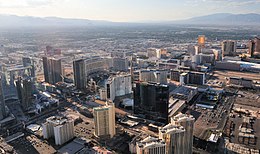
Back وادي لاس فيغاس Arabic لاس ڤيجاس ڤاللى ARZ لاس وقاس ولی AZB Las Vegas Valley CEB Las Vegas Valley Czech Área metropolitana de Las Vegas Spanish Las Vegas Valley Estonian لاس وگاس ولی Persian Vallée de Las Vegas French Wilayah metropolitan Las Vegas ID
Las Vegas Valley | |
|---|---|
 | |
| Country | United States |
| State | Nevada |
| Largest city | Las Vegas |
| Other major cities |
|
| Area | |
| • Urban | 500 sq mi (1,400 km2) |
| • Metro | 1,600 sq mi (4,100 km2) |
| Population (2018 estimate) | |
| 2,953,000 | |
| GDP | |
| • MSA | $160.7 billion (2022) |
| Time zone | UTC-8 (PST) |
| • Summer (DST) | UTC-7 (PDT) |
| Area code(s) | 702 and 725 |
The Las Vegas Valley is a major metropolitan area in the southern part of the U.S. state of Nevada, and the second largest in the Southwestern United States. The state's largest urban agglomeration, the Las Vegas Metropolitan Statistical Area is coextensive since 2003 with Clark County, Nevada.[2] The Valley is largely defined by the Las Vegas Valley land formation, a 600 sq mi (1,600 km2) basin area surrounded by mountains to the north, south, east and west of the metropolitan area. The Valley is home to the three largest incorporated cities in Nevada: Las Vegas, Henderson and North Las Vegas.[3] Eleven unincorporated towns governed by the Clark County government are part of the Las Vegas Township and constitute the largest community in the state of Nevada.[4]
The names Las Vegas and Vegas are interchangeably used to indicate the Valley, the Strip, and the city, and as a brand by the Las Vegas Convention and Visitors Authority to denominate the region.[5][6] The Valley is affectionately known as the Ninth Island by Hawaii natives and Las Vegans alike, in part due to the large number of people originally from Hawaii who live in and regularly travel to Las Vegas.[7]
Since the 1990s, the Las Vegas Valley has seen rapid growth, tripling its population from 741,459 in 1990 to 2,227,053 estimated in 2018, increasing to 2,953,000 in 2024.[8] The Las Vegas Valley remains one of the fastest growing metropolitan areas in the United States. In its relatively short history, it has established a diverse presence in international business, commerce, urban development, and entertainment, as well as one of the most visited tourist attractions destinations in the world. In 2014, a record-breaking 41 million people visited the Las Vegas area, producing a gross metropolitan product of more than $100 billion.[9]
- ^ "Total Gross Domestic Product for Las Vegas-Henderson-Paradise, NV (MSA)". Federal Reserve Economic Data. Federal Reserve Bank of St. Louis.
- ^ "Metropolitan Statistical Areas and Components, December 2005, with codes". Archived from the original on February 9, 2006. Retrieved March 23, 2007.
- ^ "2013 Estimates". Nevada State Demographer's Office. Archived from the original on February 9, 2014. Retrieved July 17, 2014.
- ^ Cite error: The named reference
Clark Countywas invoked but never defined (see the help page). - ^ Spillman, Benjamin (April 15, 2009). "LVCVA: What works here, stays here". Las Vegas Review-Journal. Retrieved May 8, 2012.
- ^ Carroll, Laura (June 12, 2013). "Cirque characters, comedy acts liven up travel trade show". Las Vegas Review-Journal. Retrieved June 12, 2013.
- ^ "Las Vegas: Bright Lights, Big City, Small Town". State of the Reunion. Archived from the original on June 2, 2013. Retrieved July 5, 2013.
- ^ "Las Vegas Metro Area Population 1950-2024". www.macrotrends.net. Retrieved December 24, 2024.
- ^ "U.S. metro areas - ranked by Gross Metropolitan Product (GMP) 2020". Statista.





